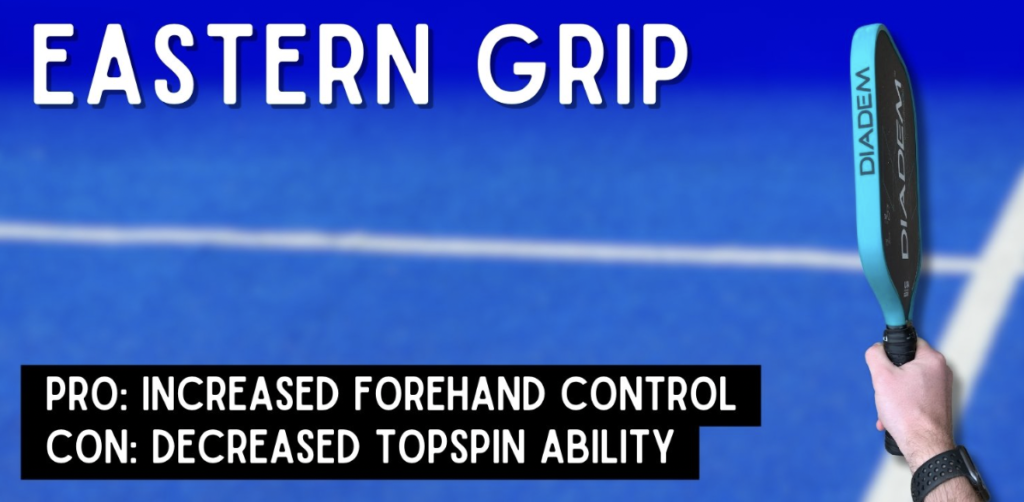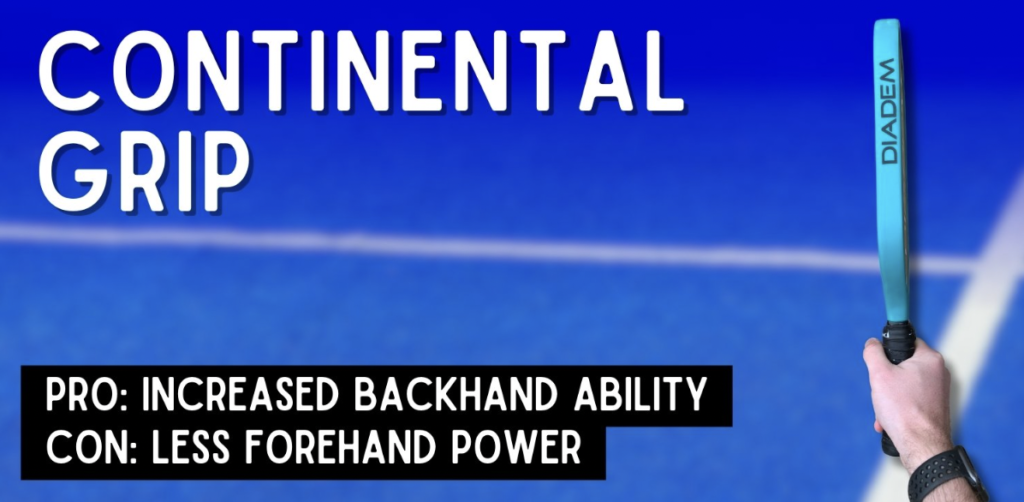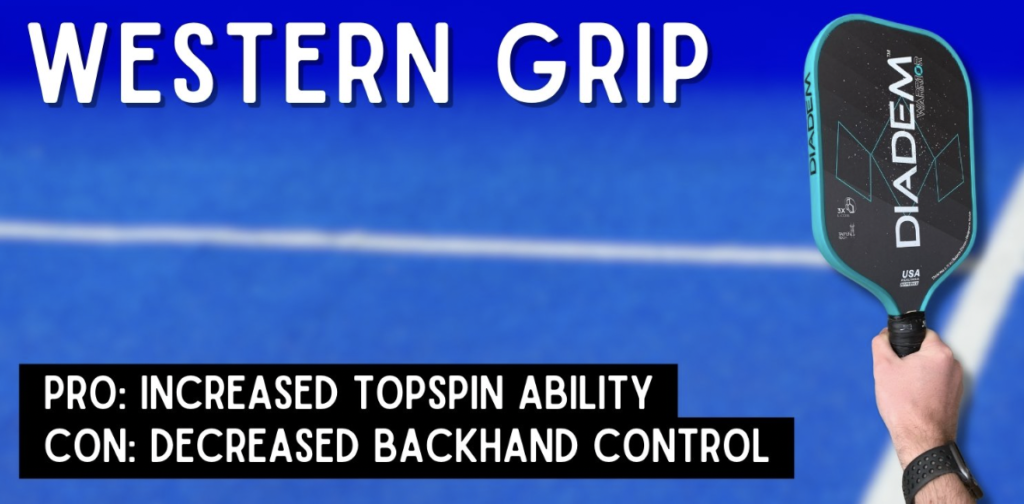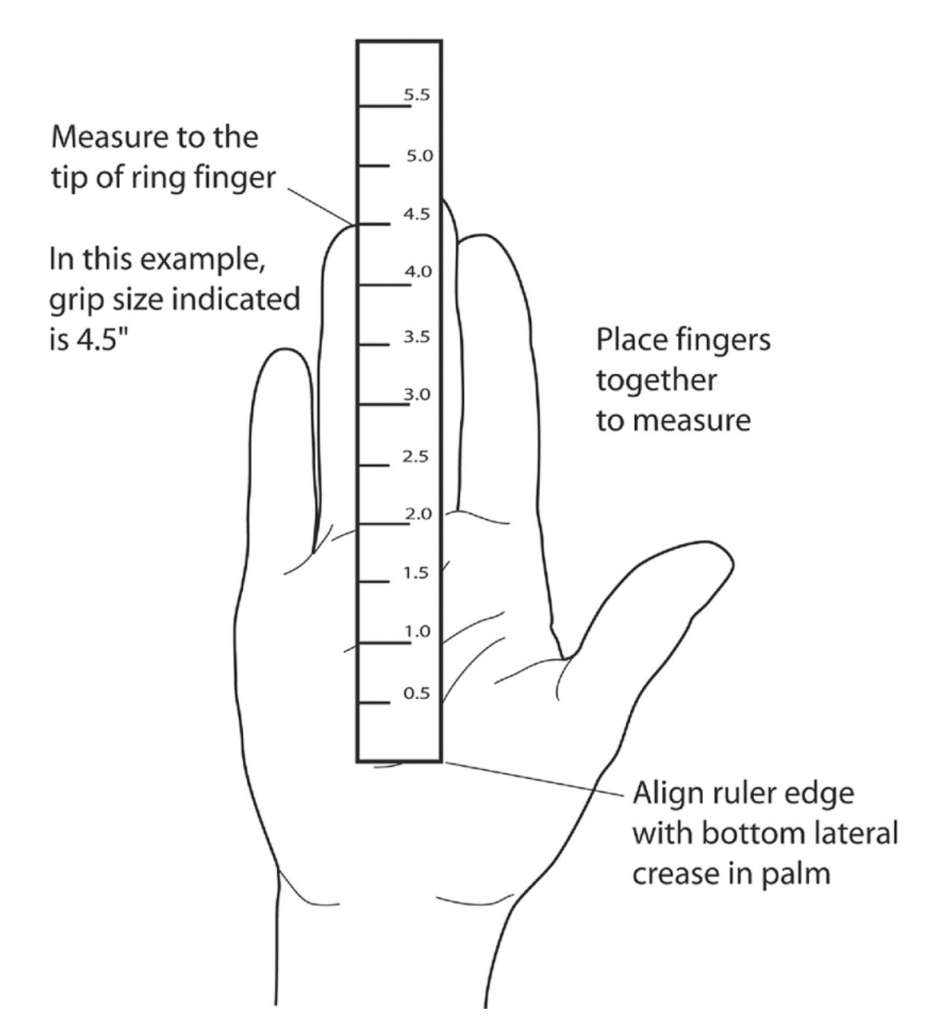How to hold a a pickleball paddle plays a pivotal role in your performance on the court. Your grip influences your ability to strike the pickleball and the types of shots you execute on the court.
So, choosing a grip that compliments your playing style and showcases your favorite shots is essential for success on the pickleball court.
In this article, we will answer the following questions, without the jargon:
- Is your grip important?
- How tight should you hold your pickleball paddle
- How to switch between different grips
- Which pickleball grip best suits your pickleball game?
- Two-Handed Backhand
- Choosing the right paddle grip size for you
Let’s start with the 3 standard grips.
The 3 Standard Grips:
1. Eastern Grip
The Eastern pickleball grip is the most popular grip in pickleball, including for newbies. Earning the nickname ‘handshake grip’, due to the way you grip the handle, mimicking a handshake.
The Eastern grip allows you to hit both forehand and backhand shots effectively. The Eastern pickleball grip is the perfect balance between forehand and backhand shots.
To adopt this grip, extend your hand as if preparing for a handshake, then grasp the handle in the same manner. Position the knuckle of your index finger on the second bevel right of the handle’s top flat bevel.
Left-handers, simply reverse this, placing your index finger’s knuckle on the second bevel left of the top flat bevel.
Here’s how it looks:

2. Continental Grip
The Continental grip is favored by newbies and veterans alike. Dubbed the ‘hammer grip’, since you hold the paddle like a hammer when hitting a nail – minus the risk of hitting your thumb!
The Continental grip delivers effective dinks and backhand shots. However, forehand shots on the court can be more challenging, given its slight bias towards backhand strokes.
To execute this grip, align the knuckle of your index finger just shy of the paddle’s top flat bevel on the right. Lefties, simply reverse this, placing your index finger’s knuckle just shy of the paddle’s top flat bevel on the left.
Here’s how it looks:

3. Western Grip
The Western grip, also known as the ‘frying pan grip’, is less common, but still seen around the courts. This grip generates effective topspin shots due to the angle of the paddle face when striking the ball, making it a good choice for more aggressive players. However, adopting this grip makes it very difficult to hit effective backhand shots.
How to Adopt This Grip:
- Start in the Eastern grip position.
- Rotate your hand right (clockwise), placing your index finger’s knuckle on the third bevel to the right of the paddle’s top. Left-handers should mirror this adjustment to the left.
- This grip, resembling the act of holding a frying pan, positions the paddle face downward, perfect for unleashing powerful topspin serves.
Here’s how it looks:

Is the grip important?
Absolutely! As we’ve explored, the way you hold your paddle is crucial to your performance in pickleball. Selecting an optimal grip can significantly enhance your playing strengths.
Variations in grip styles are common among players, especially those with a background in ping-pong, who may rest one or two fingers on the paddle face for perceived better control. However, this technique carries the risk of the ball striking those fingers during a game.
Many players customize their grips with over-wraps or replacement grips to adjust thickness for a comfortable fit or to improve grip and control.
How tight should you hold your pickleball paddle
The majority of pickleballers, particularly beginners, tend to clutch their paddles too tightly.
The optimal grip is more relaxed, focusing the hold more on the fingers than the palm. Coaches advise a grip strength of around 3–4 on a scale of 10. Adopting this approach not only enhances your sensation of the ball’s contact with the paddle but also improves your mastery over the shot’s force and trajectory.
How to switch between different grips
For beginners, sticking to a single grip style throughout a match is common, yet more advanced pickleball players skillfully switch between various grips, even from one shot to another! Despite the challenge posed by pickleball’s fast-paced and close-up gameplay, players naturally refine their ability to alter grips mid-game as they advance.
Here are strategies to become proficient in diverse grip styles and leverage them effectively on the court.
Focus on One Grip at a Time
Avoid overwhelming yourself by attempting too much at the same time. Start by mastering either the Continental or Eastern grip as a beginner. Once comfortable, proceed to the other, and tackle the Western grip last due to its complexity.
Experiment with Grips Under Various Conditions
Improvement in pickleball comes with practice. Experiment with all three grips during informal games, or consider practicing with a pickleball machine for a more structured approach.
Seek Guidance from a Professional Coach
While practicing with peers is beneficial, consulting a professional coach can significantly expedite your learning curve, making the most of your time on the court!
Continuously Experiment to Discover What Suits You Best
Don’t confine yourself to a single grip style, especially if it’s not facilitating the shots you aim for. Persist in experimenting and exploring new techniques, regardless of the outcome.
Two-Handed Backhand
Opting for a two-handed backhand in pickleball could offer a significant advantage over the traditional one-handed approach. This is due to the enhanced stability and control it provides. This grip allows players to exert additional power and precision on their backhand shots, making it a great technique for those looking to take their game to the next level. Players who adopt the two-handed backhand tend to opt for a paddle with a longer handle.
How to adopt the two-handed backhand pickleball grip
- Start with your standard one-handed backhand grip.
- Then, position your non-dominant hand above your dominant one on the paddle grip, ensuring the palm of your non-dominant hand faces the back of the paddle handle during the shot.
- You can place the index finger of your non-dominant hand on the paddle’s back face to further improve your control. This technique not only increases paddle stability but also keeps your index finger shielded from direct hits by the ball, as it is safely positioned on the reverse side of the paddle.
Choosing the right paddle grip size for you
Pickleball rules don’t specify a required thickness for paddle grips, allowing players to choose a grip size that ranges from thin to thick according to their personal preference. Typically, pickleball paddle grips vary from 4 inches to 4.5 inches in circumference, depending on what feels best in terms of weight, size, and comfort for the individual player.
If you’re uncertain about the ideal grip size for your paddle, several simple tests can help you find the perfect fit. Selecting the appropriate grip size is not only about comfort; it can also play a crucial role in preventing issues like tennis elbow, as an ill-fitting grip size might contribute to discomfort or pain.
You can use the ruler test as provided by Third Drop Shot.

Bottom Line
And there you have it, everyone! We’ve delved into the top three pickleball grips and their roles in enhancing your play. Our parting wisdom? Be flexible! Mastering all three grip techniques and knowing when to apply each can significantly up your game.
The Eastern grip stands out as both the ideal starting point for beginners and the most favored grip among pickleball players globally. However, as your skills evolve, it’s wise to venture beyond and test other grips. You might discover that a different grip aligns better with your unique playing style, giving you an edge on the court.
Eager to share some grip wisdom of your own with the pickleball community? We’re all ears on our social media channels and we would love to hear from you!
Sources
- Title: “HOW TO FIND YOUR PICKLEBALL PADDLE GRIP SIZE”. Retrieved on April 14, 2024. URL: https://www.thirdshotdrop.com/blog/find-pickleball-paddle-grip-size.htm

